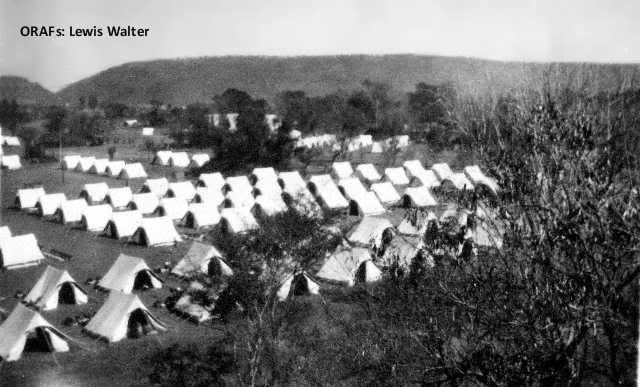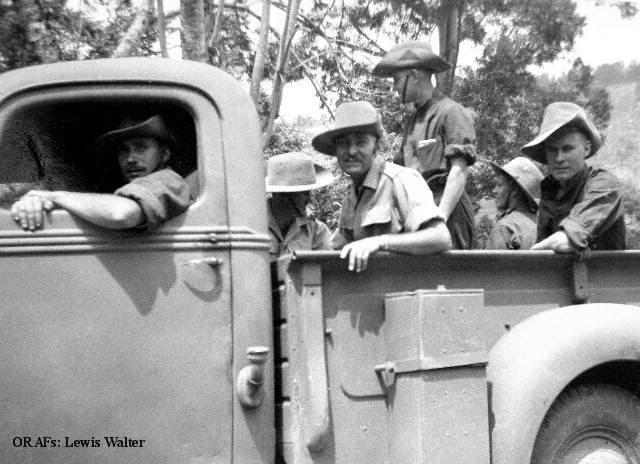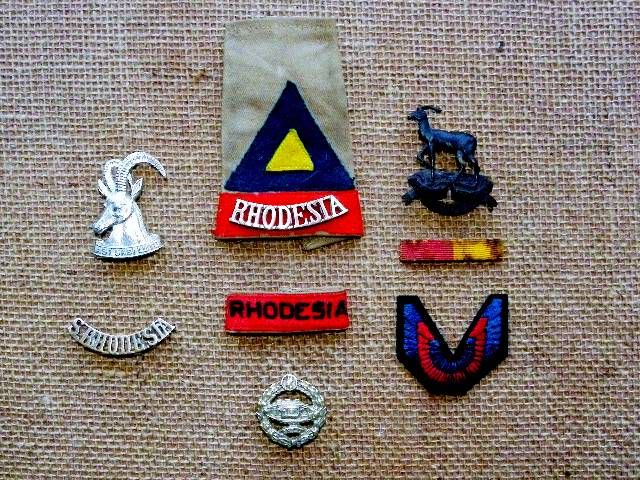Umtali to The Alps
THE SOUTHERN RHODESIA ARMOURED CAR REGIMENT
1942 to 1945
Seventy years ago, in early 1942, the new Park River Training Camp was established in Umtali basically to cater for the Southern Rhodesia Reconnaissance Unit, though the First Rhodesia Field Ambulance was also based there.

X8150 Cpl. Walter C.J

X8150 Cpl. Walter C.J
On 4th March 1942, B11002 Rifleman Walter C.J. of the 1st Battalion Rhodesia Regiment (having falsified his age downwards) was among those who were required to report to KG VI Barracks “for full-time service in the Armed Forces of the Colony”. They soon found themselves at the Umtali Training Camp, in the S.R. Reconnaissance Unit. CJW’s new Regimental Number was X8150. The Regimental Badge was the well-known Sable, with the Sindebele motto “Asi Sabi Luto” – “We Fear Nothing”. Their Regimental magazine was “The Sable”. Umtali and its surrounds were ideally situated for the nine months of intensive training which followed, and the well-known Umtali photographer E.T.Brown recorded much of the process. During this period, the Unit was renamed the S.R. Reconnaissance Regiment, and later the Southern Rhodesia Armoured Car Regiment, retaining the Sable badge. (The Rhodesia Armoured Car Regiment of Rhodesia’s final years had an adapted version of the Sable badge, and the motto was re-written as “Asesabi Lutho”). Photographs were taken in and around Umtali in 1942, some by E.T. Brown, show the men in training. Hugh Bomford in New Zealand, author of the book on the Rhodesia Regiment, was particularly interested in that of trainees in battle dress wearing steel helmets, and commented : “This photo is identified as unique on account of the sun protectors attached to the back of the helmets. Apparently the fundis (specialists) thought that the three holes in the back of the helmets were for this flap, but it has not previously been seen on a helmet or in any photo”.














Towards the end of November 1942 the Regiment was moved to Pietermaritzburg in South Africa, and on 1st December 1942 its members were attested into the Union Defence Force. CJW’s new Regimental Number was SR 598119 V, and his age was recorded as 37. He was actually 41. The 6th South African Armoured Division was being formed under Major General Evered Poole, and early in 1943 this became the Rhodesians’ new home. April brought the next stage in their great adventure – embarkation in Durban for “destination unknown”. This turned out to be Egypt, where they arrived at the end of April shortly after Tunis and Bizerta had fallen to the allies, signalling the end of the war in Africa. Most of the Rhodesians were now in the Pretoria Regiment – Princess Alice’s Own – which had its own badge comprising an Impala over the name of the Regiment. They also apparently were entitled to wear the badge of the 6th SAAD which depicted a tank surrounded by a laurel wreath with the motto “Ons Is” – “We Are”. Individuals in the same photographs are shown wearing either one or the other. Presumably there was some reason for this.
Month after month of intensive training and desert manoeuvres with Sherman tanks followed, but the troops were getting impatient for action. Towards the end of the year, to allay this, they were addressed by Field Marshal Smuts who assured them that their time for action would come. Meanwhile, the 6th Division was becoming the Allies’ most formidable armoured force.
Photographs taken in Egypt during 1943 and early 1944 show the rough living conditions of the men. They did, however, have time to sight-see the antiquities of the country around them, and CW described many in letters home. These included the pyramids, Sphinx, and the Temple of Karnak









At last, in April 1944, the time for action came, and the 6th Division with its Rhodesian complement embarked for Italy. It was among those destined to face the German Gustave Line. Their first major action was the attack on Monte Cassino in May, and they then moved relentlessly Northwards, but is not in the scope of this article to record in detail their onward progress – that must be left to those more qualified.
Soon after Cassino, the 6th Division was joined by the British 24th Guards Brigade, which had been placed under the command of General Poole. Their function was to provide infantry support in view of the mountainous terrain in which the 6th Div. would operate. The 24th consisted of the 5th Battalion, Grenadier Guards, the Second Coldstreams, and the First Scots. A squadron of the Pretoria Regiment was attached to each of these. Most of the Rhodesians (including CJW) were now in “A” Squadron. In a break with tradition, the Guards wore the 6th Division’s green and yellow triangle. The British, South Africans and Rhodesians combined to make a formidable and most effective force, with each soon recognising the special qualities of the others.
Together they fought their way Northwards, and the Pretoria Regiment became renowned for its extraordinary ability to get its tanks to mountainous places others thought to be impossible.
In July they entered Florence, the first Allied troops to do so, and by an unusual agreement between combatants, the historic bridge, the Ponte Vecchio, on the Arno was left untouched. I recall CJW writing to us to describe these events, and the miraculous survival of the bridge. He also wrote later about a performance of Puccini’s “Madam Butterfly” in la Scala, Milan, and the wonderful “firefly” effects produced on stage.
Photographs sent home from Italy recorded some of the realities of war, but also the more relaxed side which the men were occasionally able to enjoy. These included tobogganing in the snow, or sunning themselves beside a picturesque lake. One photo proudly records the capture of a self-propelled 88-milimetre rapid-fire gun near Florence. The Germans used these weapons with devastating effect.













The close association between the Guards and particularly the Pretoria Regiment continued through the bitter winter months until 17th February 1945, when as a result of new formations, their ways were to part. At the farewell parade on 25th March 1945, the men of the Pretoria Regiment were awarded the honour of wearing the colours of the Guards Brigade as a background to their own badge.
Dave Fyfe, who was a member of the 6th SA Armoured Division and present at the parade, wrote to me :
“The Pretoria Regiment (Princess Alice’s Own) were not assembled as a regiment on parade. Their tanks were lined up in several rows, each with its crew of five standing in front of their tank. It had been a very happy association. The 24th Guards Brigade consisted of the 5th Battalion Grenadier Guards, the Second Coldstreams and the First Scots. A Squadron of the Pretoria Regiment was attached to each of these battalions.
“ The Guards were accustomed to infantry going in first on encountering the enemy. They found the South Africans had reversed the process. The tanks went first. They thought that was terrific. Other perks, unknown in their army, were 100 free cigarettes per week, occasional “Glory bags” from well-wishers in South Africa with hand-knitted socks, razor blades, soap etc., and later, when winter came in the snow-covered Apennines, a nightly tot of brandy. They had never had it so good. Towards the end of the Italian campaign, to their horror, they were moved back to a British Division.
“After the war was over, our General W.H.Evered Poole had cause to go to London. He took Norman Eikman – a Corporal in our Unit – who had been his personal radio operator throughout the length of Italy – with him. While there, Eikman visited a number of Guards’ barracks. On return he told me he had been impressed to see the 6th S.A. Division flash in a little frame above many beds. They had been proud to wear it while with us”.
An official press release after the award parade records that “……This honour is bestowed to perpetuate the splendid work carried out by the Pretoria Regiment in support of the Guards Brigade”. In return, to show their appreciation of the association, every man of the Pretoria Regiment donated a day’s pay towards the restoration of the Guards’ Chapel in London, which had been severely damaged by the enemy during a bombing raid.
The war wound on to its inevitable conclusion. Germany capitulated on 2nd May 1945, and Victory in Europe was announced on 8th May. For the members of the 6th South African Armoured Division, the Rhodesians among them, the culmination of it all was the impressive Victory Parade at Monza, North Italy, in June. This took three hours to pass the saluting base, so great was the assemblage of armour.
Then followed months of frustration and delay for the troops, and also for their families in Rhodesia and South Africa. CJW eventually arrived back in South Africa, and was formally discharged from service in the 6th SAAD on 4th December 1945. He was finally discharged from the Southern Rhodesia forces on 4th January 1946.
Those who served all the way through qualified for the following awards :
The 1939-1945 StarThe Africa Star
The Italy Star
The Defence Medal
The War Medal
The Africa Service Medal
The Africa Service Medal was affectionately known as “Ouma’s Garter”, in honour of “Ouma” Smuts, beloved wife of Field Marshall Smuts.

Text for above:-

Text for above:-
Guards Pretoria Honour Regiment Lieut.-General Sir Henry Lloyd, Major-General Commanding a brigade of Guards, has obtained the full approval of Lieut. General Sir Alfred Codington, Senior Colonel of the Brigade of Guards, to the request from the Guards Brigade for the Pretoria Regiment (Princess Alice's Own) to be given the addition of the Household Brigade colour (scarlet and blue) in cloth as a back- ground to the badge of the Pretoria Regiment.
This honour is bestowed to perpetuate the splendid work carried out by the Pretoria Regiment in support of the Guards Brigade.
ROLL OF HONOUR OF RHODESIANS KILLED WHILE SERVING WITH THE PRETORIA REGIMENT, 6TH SOUTH AFRICAN ARMOURED DIVISION
Regimental Number: SR598158
Rank: Tpr
Name: Bodington, JH
Squadron: A
Date of Death: 1 July 1944
War Cemetery: Assisi
Regimental Number: SR598048
Rank: Cpl.
Name: Bowley, BB
Squadron: A
Date of Death: 12 June, 1944
War Cemetery: Bolsena
Regimental Number: SR598523
Rank: Tpr.
Name: Crawford, JW
Squadron: A
Date of Death: 1 July, 1944
War Cemetery: Assisi
Regimental Number: SR598058
Rank: Tpr.
Name: Davidson, John P
Squadron: A
Date of Death: 27 July, 1944
War Cemetery: Florence
Regimental Number: SR598142
Rank: Sgt.
Name: Den, D
Squadron: A
Date of Death: 22 November, 1944
War Cemetery: Castiglione
Regimental Number: SR598158
Rank: Tpr.
Name: Hamman, GFB
Squadron: C/A
Date of Death: 12 June, 1944
War Cemetery: Bolsena
Regimental Number: SR598356
Rank: Tpr.
Name: Harvard, JI
Squadron: C/A
Date of Death: 1 July, 1944
War Cemetery: Assisi
Regimental Number: SR598000
Rank: L/Cpl.
Name: Kitcat, G de W
Squadron: A
Date of Death: 2 August, 1944
War Cemetery: Foiano Della Chiana
Regimental Number: SR597778
Rank: Tpr.
Name: Meyer, SJ
Squadron: A
Date of Death: 1 July 1944
War Cemetery: Assisi
Regimental Number: SR598417
Rank: L/Cpl
Name: van Rooyen
Squadron: R
Date of Death: 15 June, 1944
War Cemetery: Bolsena
Regimental Number: SR598601
Rank: Lt.
Name: Walker, J
Squadron: A
Date of Death: 5 July, 1944
War Cemetery: Arezzo
Regimental Number: SR597957
Rank: Cpl.
Name: Wiley, PAH
Squadron: A
Date of Death: 26 June, 1944
War Cemetery: Bolsena
(This Roll of Honour was kindly provided by Alan Harris, who is compiling records of Rhodesians killed in WW2. If any relatives of the above have photographs of them, please contact Alan by e-mail at alanandirene@telkomsa.net )

Lewis Walter,
Fish Hoek, Cape.
March 2012.
End
Thanks to Lewis for sharing his memories of his Father and for sharing the photos with us.
Comments are always welcome - send them to Eddy Norris on orafs11@gmail.com
Suggested viewinjg - Avertisement for the Regiment
Visit. http://rhodesianadvertisements.blogspot.com/2013/05/rhodesian-armoured-car-regiment.html


0 Comments:
Post a Comment
Subscribe to Post Comments [Atom]
<< Home